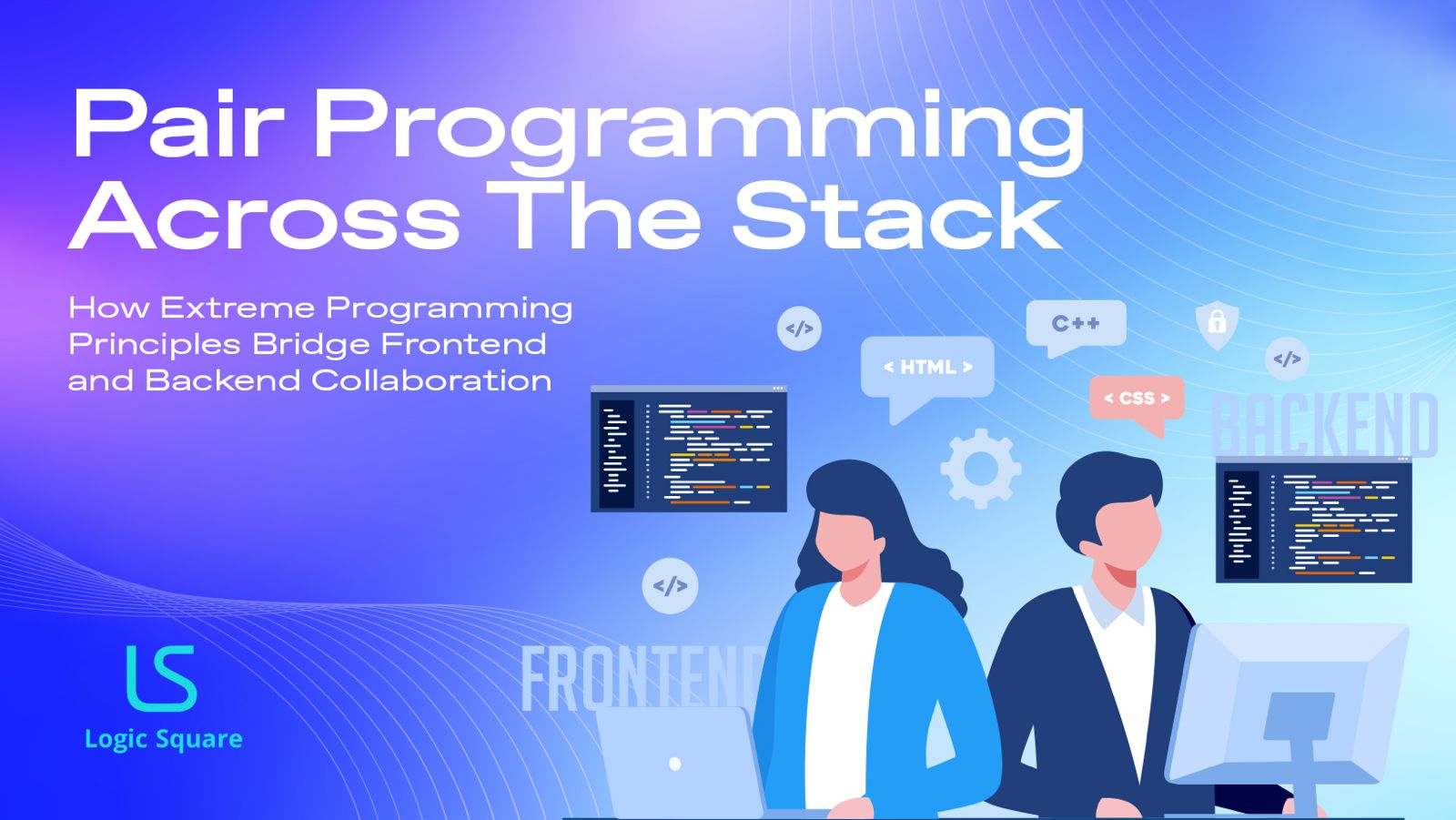The feature was supposed to be simple: a form submission that updated user data. However, the frontend developer didn’t know the API expected a user_id in the payload, and the backend developer didn’t realize the frontend was already formatting dates differently. Result? Hours lost in debugging, heaps of tense Slack messages, and yet another missed deadline.
Well, this scenario is all too familiar in a custom app development company. Despite working on similar products, frontend and backend teams often operate in silos. They write and test code separately and only discover integration issues during late-stage quality analysis, or even worse, in production.
Table of Contents
ToggleIn today’s fast-moving software era, this model is no longer sustainable. This disconnect slows down the delivery process, leads to frustrating reworks, and creates brittle systems. However, there’s a way out – pair programming, especially when rooted in extreme programming (XP) principles, rolls out a proven method to bridge the frontend and backend divide and create cohesive, high-quality applications faster and smoother.
A Quick Primer on Extreme Programming (XP)
Before diving into the aspect of cross-functional pairing, let’s review Extreme Programming quickly. Born in the 1990s as a smarter response to software complexity, XP is a software development approach built on five core values.
- 1. Communication
- 2. Simplicity
- 3. Feedback
- 4. Courage
- 5. Respect
These values foster practices that promote collaboration and rapid, high-quality development. Let’s take a look at some of the most notable approaches that can create big impacts.
- Pair Programming – Two developers collaborate and work together at one workstation.
- Continuous Integration: Continuous Integration (CI) – Code is integrated frequently and tested automatically.
- Test-Driven Development (TDD) – Tests are written before code to guide development
- Collective Code Ownership – Everyone is responsible for all code, eliminating silos.
While often associated with backend-heavy teams, these practices shine brightest when applied across the full stack.
What Does Cross-Stack Pair Programming Look Like?
Cross-stack pair programming is the practice of pairing developers from different areas of the stack, typically one frontend and one backend developer, to collaborate in real time on a shared goal.
Real-World Scenarios:
- End-to-End Feature Development: Designing a new user profile page? A cross-functional pair can collaborate on UI layout, API contracts, and data persistence together.
- Full-Stack Debugging: A bug that manifests in the UI but stems from an inconsistent API? Pairing lets both sides trace the issue in one session.
- Story Kickoffs and Spikes: Pairs can explore technical solutions together, preventing mismatched assumptions down the line.
Tooling and Environment:
To make this effective, mobile app development companies should invest in tools like:
- VS Code Live Share or Tuple for real-time collaboration.
- Shared dev environments with synchronized servers and databases.
- Agile rituals, like story kickoffs to align goals before coding begins.
The Benefits of Cross-Functional Pairing
When teams embrace cross-stack pairing, the results are tangible:
1. Improved System Understanding
Developers start to see the big picture. Backend developers learn UI priorities; frontend developers understand API limitations. This shared context leads to better decisions.
2. Faster, More Cohesive Development
Instead of back-and-forth over Slack or waiting for handoffs, pairs can solve problems as they arise. One app development company reported that features that used to take two sprints now ship in just a few days.
3. Better API Design
APIs evolve collaboratively during pairing, rather than in isolation. This reduces the mismatch between how APIs are built and how they’re consumed.
4. Higher Code Quality
With TDD and real-time peer review baked in, defects are caught early. Combined with XP’s continuous integration practices, quality becomes a natural output of the process.
5. Knowledge Sharing and Onboarding
New team members or developers transitioning from frontend to backend (or vice versa) ramp up faster by pairing. It also reduces the “bus factor” by spreading knowledge across the team.
Challenges and How to Overcome Them
Despite its advantages, cross-functional pairing comes with hurdles.
1. Skill Gaps and Intimidation
Not every frontend developer is comfortable with backend logic, and vice versa. The key is psychological safety. Encourage a culture where asking questions is welcomed and learning is celebrated.
2. Scheduling Conflicts
Time zones and sprint logistics can complicate pairing. Use timeboxing and ensure pairs are formed during sprint planning. Aim for short, focused sessions—90 minutes with clear goals often works well.
3. Context Switching Fatigue
Pairing across stacks can be mentally taxing. Avoid full-day pair sessions. Instead, break work into 1-2 hour chunks and rotate pairs regularly.
4. Tooling Friction
Not all teams have the right tools to support seamless collaboration. Invest in collaborative IDEs, standardized environments, and reliable CI pipelines.
Real-World Case Study: Before & After Cross-Stack Pairing
At one mobile app development company, product delivery had slowed to a crawl. Features took 2-3 sprints to complete, bugs were common, and developers rarely talked outside their domain.
After a shift to XP-style cross-stack pairing:
- Deployment frequency increased from weekly to daily.
- Bug count dropped by 45% within the first quarter.
- Average time to complete features decreased by 60%.
One senior engineer remarked, “We used to blame each other’s code. Now we solve problems together.”
Practical Tips for Getting Started
Ready to try cross-stack pairing at your custom app development company? Start small and iterate.
- Start with Low-Risk Stories: Pick small bugs or simple enhancements to test the pairing model.
- Encourage Voluntary Pairing First: Let developers opt in before making it a team-wide practice.
- Rotate Pairings Across Disciplines: This helps spread knowledge and avoid comfort zones.
- Include Pairing in Sprint Planning: Allocate time and capacity explicitly for pairing.
- Celebrate Pairing Wins: Call out successful pair sessions in retrospectives or demos.
Conclusion: From Silos to Synergy
Extreme Programming isn’t just for backend engineers or high-stakes legacy systems. Its principles—communication, feedback, simplicity—are universal, especially valuable in modern, full-stack teams.
Pair programming across the stack turns isolated developers into collaborative problem-solvers. It shrinks feedback loops, aligns expectations, and makes delivery smoother and faster.
For any app development company looking to increase velocity, reduce bugs, and foster stronger teams, cross-stack pairing is a game-changing practice.
Parting Thoughts,
If your next sprint includes a feature that spans the frontend and backend, try assigning a cross-functional pair. Start with just one story, observe the results, and build from there. Bridging the frontend-backend divide doesn’t require a reorg or a new tool; it starts with a shared keyboard, shared context, and a shared commitment to building better software together.
Connect with us today to discuss your next AI project. Let’s work on something revolutionary, together!





